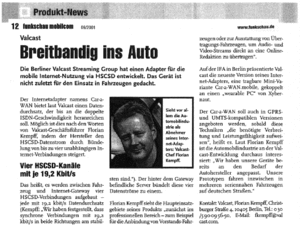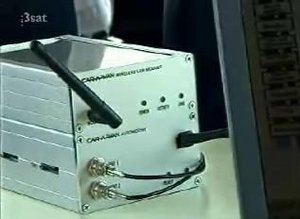24.08.2001 - Games, UMTS and video streaming: IFA divides mobile wireless users
When it comes to mobile wireless, things are likely to hot up where wireless technologies like HSCSD supply car drivers with up-to-date information – from navigation aids through e-mails to websites. The Berlin firm Valcast demonstrates e.g. how videos can be transmitted to and from moving vehicles at a speed similar to that of ISDN. Right in time for the fair, the necessary hardware is now available as standard. Source: VDI no. 34 of24.8.2001 page 20
24.08.2001 - Totally digital: The 2001 International Consumer Electronics Fair
The car too will not remain excluded from multimedia communication on the Internet. The future scenarios of the coming broadband mobile wireless system, UMTS, can be seen at this year's Ifa.
Already today, new transmission processes are getting higher speeds out of conventional mobile phone networks. For example, the Berlin company Valcast is presenting an Internet adapter called "CAR-A-WAN", which is said to almost reach ISDN speed in the GSM mobile phone network. The adapter would thus be suitable for comfortable Internet surfing or e-mail communication from a moving vehicle without additional aid.
Already last year, the company presented a prototype, which transmitted images and sounds live from a city taxi in Berlin for three months, 14 hours a day. Now the hardware is available commercially. The producer sees its main areas of use initially in the professional sector. Source: Der Tagesspiegel no. 17507 of 24.8.2001 page 30, Tagesspiegel.de
01.09.2001 - Internet video: From the board members' limousine onto the Internet
Not simply the Internet in the car, but immediately with double ISDN speed from the vehicle onto the web? What at first sight looks like another crazy idea from the start-up ideas tool kit can in fact offer new, low-cost communication possibilities for very busy top managers or for sales staff who are constantly on the move. At least, that's what the Berlin-based Valcast Streaming Group believes, who recently before the International Consumer Electronics Fair presented their "CAR-A-WAN", an Internet adapter for the car which provides super-fast access to the Internet even without the new mobile wireless technologies UMTS and GPRS. The prototype of the adapter already made it possible last year for direct video transmissions from a Berlin city taxi to be seen on the Internet.
The mobile broadband system is based on HSCSD technology, which can be used on D2 and E-Plus networks, and ultimately does little more than bundle several wireless channels. The CAR-A-WAN uses up to four such channels. Of course, this makes using it more expensive than a normal mobile phone call, partly due to higher subscription charges. For Managing Director Florian Kempff, the technology is nonetheless the low-cost version of mobile broadband communication. However, the Valcast Streaming Group does not want to finally decide on HSCSD – they are also working on versions for the new mobile wireless standards GPRS and UMTS. Source: Creditreform no. 9 of 1.9.2001 page 30
10.09.2001 - Live transmission from the car
The Berlin-based company Valcast.com has developed an Internet adapter for cars. The normal GSM mobile phone network and the so-called HSCSD, already available for use in Germany, are used for channel bundling.
In this way, it is said to be possible to surf the Internet on your laptop using broadband via the mobile phone network. Even video transmissions or live streaming from the moving vehicle are possible with this product, according to Valcast.com. It may therefore appeal to web editors and TV providers. Source: Handelsblatt no. 174 of 10.9.2001 page 15
11/2001 - Broadband comes to the car

Berlin-based VALCAST has developed an adapter for mobile Internet use via HSCSD. The device is not least intended for use in vehicles.
According to VALCAST, the Internet adapter called CAR-A-WAN offers a data throughput rate approaching double ISDN speed. According to IPmotion Managing Director, Florian Kempff, this is possible because the manufacturer increases the HSCSD data stream by bundling up to four independent Internet connections.
This means that four HSCSD connections are established between a vehicle and an Internet gateway, each with 19.2 kbit/s data throughput. The server after the gateway bundles these four data streams into one.
Florian Kempff sees the main areas of use of his product "initially in the professional sector – for example for the connection of management board vehicles or equipping of transmission vehicles, so that audio and video streams can be transmitted directly to online editors."
At the IFA in Berlin, VALCAST presented the latest version of its Internet adapter, a portable mini-variant called the CAR-A-WAN.mobile, linked to a wearable PC from Xybernaut. Source: Funkschau Mobilcom
16.03.2002 - Interview with Florian Kempff by presenter Tim Cole about "Internet in the car" at CeBIT 2002
01.07.2002 - Interview with Florian Kempff by presenter Harald Platz about "UMTS and mobile Internet" on "Neues"
11.09.2003 - Euroopas oli siiani vaid üks netiühendusega rong GPRS-ühendus sobib peamiselt e-posti lugemiseks

Eilsest pakub Edelaraudtee ametlikult Tallinna-Tartu kiirrongi I klassi vagunites reisijatele tasuta internet iühendust, tegemist on esimese ja ainsa rongis pakutava netiühendusega Baltikumis. Quelle: Eesti Päaevaleht Online, PDF
13.03.2003 - When everyone's watching videos, no one can make a call
... At the CeBIt, the Marburg-based firm IPmotion wants to demonstrate that no new high-performance technologies like UMTS are necessary for videos on your mobile phone: With the CAR-A-WAN, it is marketing a router which transmits moving images via existing GSM networks. The trick: The data channels of four HSCSD/GPRS mobile phones are bundled. In this way, video images the size of a cigarette packet can be transmitted. "The main customer is a car manufacturer which needed full Internet access for the car," explained Managing Director Florian Kempff. Source: Welt Online
18.01.2006 - Web-linked bus for World Cup team

Germany's national soccer team may not be the most tech-savvy in the world, according to its manager, but things could improve with the introduction of a Web-connected bus to get them to and from matches. Until recently, some of the players still depended on fax machines to communicate with each other, said manager and former soccer star Oliver Bierhoff, at a technology forum Tuesday at Munich's new football stadium. "Now most of them have e-mail," he said. "Believe it or not, though, we still have a few players who struggle with this new medium, and we intend to help them. "The players may soon be able to improve their tech skills by using their downtime on the team bus to surf the Web, reply to fan e-mail or download video clips. IPmotion GmbH demonstrated its technology for linking moving vehicles to the Internet in the German team's official bus parked outside the new stadium. "We're in talks to have the technology installed for the World Cup games," said IPmotion Managing Director Florian Kempff, in an interview inside the luxury bus. "A lot of other clubs have expressed interest as well. "IPmotion's system, called Car-A-Wan, can connect cars, trucks and buses to the Internet via a mix of GSM (Global System for Mobile Communications) and wireless technologies, including GPRS (General Packet Radio Service), 3G (third-generation), EDGE (Enhanced Data for GSM Evolution) and WLAN (wireless LAN). "The technology works according to the least-cost routing principle by searching for the best connection while the vehicle is moving," Kempff said. "It is designed to get the maximum capacity out of a data connection, unlike many handsets designed, which frequently have a lower quality link to preserve their batteries. "In the future, IPmotion plans to add WiMax technology, which promises higher speeds and greater coverage than early Wi-Fi systems, he said. Asked about demand for Internet access on a team bus, Matthias Tausendpfund, managing director of Web content provider Tomorrow Focus Technologies GmbH, said many players use the downtime today to send text messages from their phones or play on game consoles. "I think many of them would love to have a wireless device when they're on the road," he said .Siemens AG, which sponsored the technology forum, was selected by the German Football Association a couple of years ago to provide technology consulting services. Quelle: itWorldCanada

